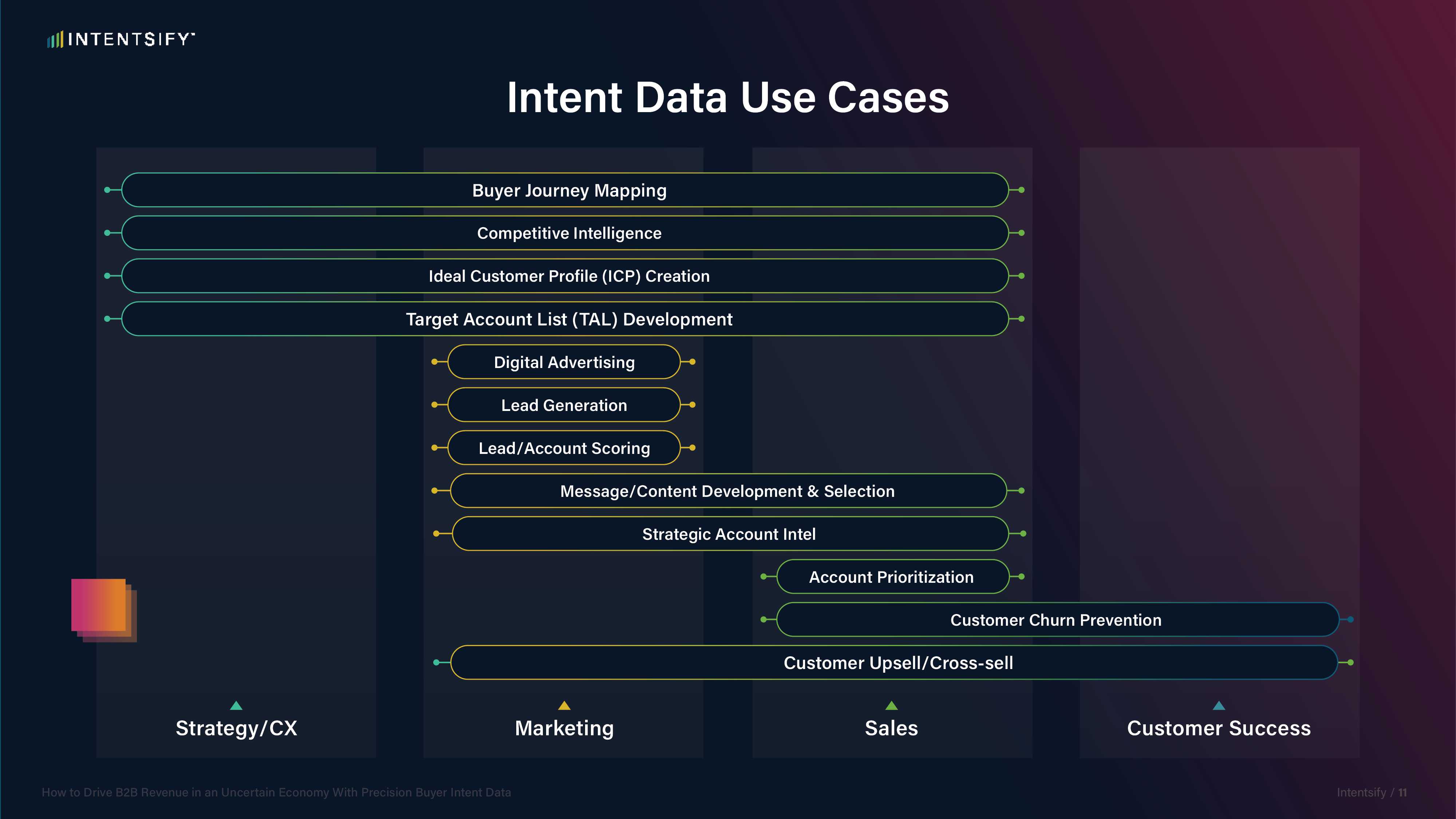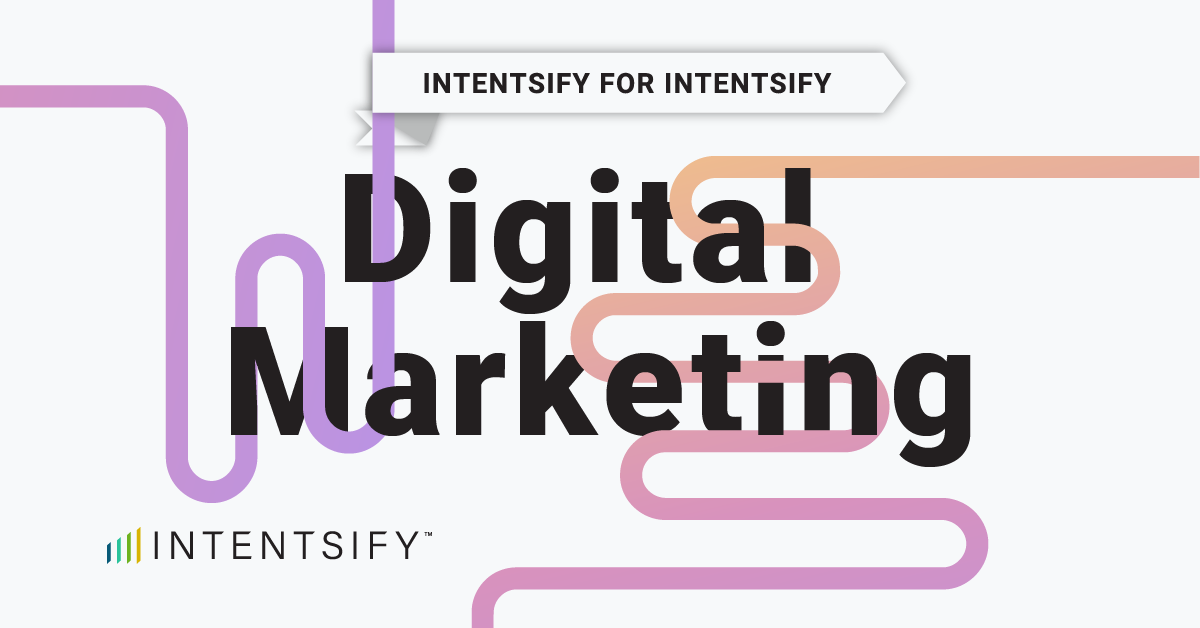92% of B2B teams are investing in intent data. Most of them don’t know how to effectively use it. Wouldn’t it be nice to head into 2024 knowing your go-to-market teams are getting the most out of every investment you’re making, all while improving your buyers’ experiences?
Let us take you through twelve use cases that put your intent data to work for you and give your team the gift of options this holiday season. And don’t worry, we’re going to break this down is the simplest way possible because it’s December and you don’t have time to read a novel.

Use Case #1: Buyer Journey Mapping
Primary Functional Owner(s): Strategy/CX, Marketing, Sales
Who Uses It: Data Science, Buyer Intelligence, Customer Experience, Product Marketing, Demand/Growth/ABM, Sales Leadership
Why Are They Using It? Revenue teams often struggle to understand exactly how buyers behave and you’re left to guess what touchpoints to establish to increase the speed at which you get a contract into their hands. But there are also benefits on the buyer side. Optimizing strategy to ensure the right content is being presented to enhance their research and touchpoints from your sales team are coming at the right time will heighten the experience.
Use Case #2: Competitive Intelligence
Primary Functional Owner(s): Strategy/CX, Marketing, Sales
Who Uses It: Data Science, Buyer Intelligence, Customer Experience, Business Strategy/Intelligence, Product Marketing, Sales Leadership
Why Are They Using It? Teams are using intent data for competitive intelligence because they can gather insights into what messaging from your competitors’ is resonating with your target audience. You can also identify what accounts are researching specific competitor solutions and arm your team with takedown tactics.
Use Case #3: Ideal Customer Profile (ICP) Creation
Primary Functional Owner(s): Strategy/CX, Marketing, Sales
Who Uses It: Data Science, Buyer Intelligence, Product Marketing, Demand/Growth/ABM, Sales Leadership
Why Are They Using It? There are two sides to ICP creation: reinforcing what you already know to be true about your target personas, industries, etc. and uncovering previously unknown buyer audiences that you might not have thought to include. With an ICP that’s backed by intent data, your team is set up to effectively market to every potential persona that contributes to your revenue goal.
Use Case #4: Target Account List (TAL) Development
Primary Functional Owner(s): Strategy/CX, Marketing, Sales
Who Uses It: Data Science, Buyer Intelligence, Customer Experience, Business Strategy/Intelligence, Product Marketing, Demand/Growth/ABM, Digital Marketing, Sales Leadership, Account Executives
Why Are They Using It? Your TAL should be always updating. Having access to intent data that provides real-time insights allows your team to frequently and precisely update lists of named accounts and they’ll have access to those accounts’ buying behaviors.
Use Case #5: Message/Content Development and Selection
Primary Functional Owner(s): Marketing, Sales
Who Uses It: Content Marketing, Product Marketing, Demand/Growth/ABM, BDRs/SDRs, Account Executives
Why Are They Using It? We’ve agreed as an industry that random acts of content are banned. The goal is to always be producing content that resonates with your buyers and complement their research and deliver it at the best time possible. Having access to intent intelligence that helps you write effective nurture tracks and personalize your website according to research trends is the key to better marketing. Your sales team also benefits because they’re able to craft talk tracks that are relevant to a prospect’s recent research versus a generic shot in the dark.
Use Case #6: Digital Advertising
Primary Functional Owner(s): Marketing
Who Uses It: Digital Marketing, Demand/Growth/ABM
Why Are They Using It? Impressions aren’t cheap. When digital teams can ensure that the ads they create are only being served to those that are actively in market and researching solutions like yours, you can scale your media spend and rest easy at night knowing you’re improving your buyer engagement outcomes.
Use Case #7: Lead Generation via Content Syndication
Primary Functional Owner(s): Marketing
Who Uses It: Demand/Growth/ABM
Why Are They Using It? Similar to your display advertising strategy, marketing teams need to ensure they are delivering the right long-form content at the right time to in-market buyers. When reinforced by intent data, lead gen efforts on any channel but specifically content syndication will yield higher conversion rates, boost penetration into target accounts, improve marketing’s credibility to sales, and of course, scale ROI on lead gen investments.
Use Case #8: Lead/Account Scoring
Primary Functional Owner(s): Marketing
Who Uses It: Marketing Ops, Demand/Growth/ABM
Why Are They Using It? Marketers must allow engagements and intent models to inform how accounts and leads should be scored. If you’re noticing specific topics and keywords outperforming others, that can influence how many extra points they receive or what sales stage they should be assigned to.
Use Case #9: Strategic Account Intelligence
Primary Functional Owner(s): Marketing, Sales
Who Uses It: Demand/Growth/ABM, Sales Leadership, Account Executives
Why Are They Using It? Most teams have are holistically practicing or have a component of ABM included in their strategy. Intent data allows marketing teams to understand specific behaviors from named accounts and build custom assets and touchpoints to tailor the buying experience. Sales can also penetrate accounts in a more meaningful way when armed with intent intelligence.
Use Case #10: Account Prioritization
Primary Functional Owner(s): Sales
Who Uses It: BDRs/SDRs, Account Executives
Why Are They Using It? By leveraging intent intelligence, sales can allocate their efforts to accounts that are actively in-market and doing relevant research. This allows them to focus on accounts that have a higher likelihood of converting into opportunities – translating to a lower customer acquisition cost and faster deal cycles.
Use Case #11: Customer Churn Prevention
Primary Functional Owner(s): Sales, Customer Success
Who Uses It: Account Executives, CSMs
Why Are They Using It? Account teams can create intent models to monitor research behaviors on current accounts. By carefully monitoring keywords and topics – and setting that model to show competitor names or products – your team can quickly identify churn risks and make a plan to resolve the issue early.
Use Case #12: Customer Upsell/Cross-sell
Primary Functional Owner(s): Sales, Marketing, Customer Success
Who Uses It: Account Executives, Customer Marketing, CSMs
Why Are They Using It? Similar to the intent model you would set up for churn prevention, you can set up a model to show what if current customers are researching solutions you offer but they aren’t yet investing in. This allows your team to scale account investments, act as a strategic advisor to your customers and ideally, see an increase in customer lifetime value.
Get More Out of Your Intent Investment
With more use cases added to your team’s arsenal, it would be impossible to not notice a change in 2024. When used correctly, intent data serves multiple functions and provides teams with confidence on what accounts or prospects to focus on. Once that muscle is fully functional across the whole GTM team, the ripple effects on revenue, efficiency and customer acquisition costs are easily measurable.






